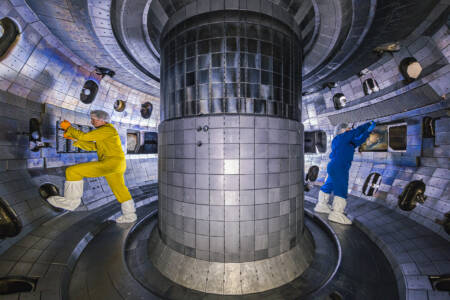What if the future of energy could be as limitless as the stars? As nuclear fission powers today’s reactors, researchers are looking toward nuclear fusion as a cleaner, safer, and long-lasting source of energy.
Nuclear power plants are largely considered as one of the most reliable sources of energy. Inside the plants, reactors use fission to heat water into steam, which is then used to spin turbines and produce carbon-free electricity. However, nuclear fission produces nuclear waste, which requires great amounts of regulation for safe storage and disposal.
Nuclear fusion, on the other hand, does not create long term radioactive waste. For years, scientists and experts have been looking to harness the power of nuclear fusion, but there has been no long term success due to the incredible amounts of pressure and high temperatures required in the nuclear fusion process.
A team of researchers have been working on potential solutions to this issue for the past three years.
The Nuclear Fusion Project is the result of a collaboration between Carnegie Mellon Robotics Institute research professor Jeff Schneider, students from both the Robotics Institute and Machine Learning Department, and the Princeton Plasma Physics Lab. With funding from the Department of Energy, the team has been able to make significant advancements using artificial intelligence (AI) to help control the challenging dynamics of nuclear fusion.
Fission and fusion differ in how they create energy. Fission occurs when a neutron collides with a larger atom, forcing the atom to excite and split into two smaller atoms. Fusion occurs when two atoms collide and create a heavier atom, such as when two hydrogen atoms combine to create a helium atom. This process produces the intense energy that fuels the sun and stars.
“We would like to mimic that process here on Earth in some way that’s controlled,” said Jeff Schneider. “The most successful way we’ve discovered so far is with a tokamak.”

Workers perform maintenance inside the DIII-D tokamak
Inside of tokamak reactors, hydrogen is superheated until it becomes a plasma. The plasma is formed into a donut shape, which is wrapped by magnets. The magnetic fields keep the plasma in place while it is heated to the temperatures and pressures needed to create a fusion reaction.
“The problem is all the dynamics of the process are non-linear and unstable,” said Schneider. “What we’re doing is using AI to learn those dynamics and, more importantly, learn controllers that do online adjustments at high speeds to keep the plasma in place.”
In June, the team brought together AI experts and plasma physicists to conduct experiments with the tokamak at the DIII-D National Fusion Facility in San Diego. The team focused on using machine learning algorithms to prevent a plasma instability known as a tearing mode. By employing a heating method similar to microwave technology, they targeted the heating to suppress tearing modes. As a result, they successfully reduced their occurrence during the experiment. A paper detailing these exciting results is currently in progress.
The Department of Energy has renewed its grant, providing an additional three years of funding for the team’s research. Building on their previous successes, they are preparing for their next experiment, which aims to further investigate the application of reinforcement learning in controlling key aspects of plasma behavior. This ongoing work is positioning Carnegie Mellon University as one of the leaders in global nuclear fusion research.
The implications of successful nuclear fusion are immense, offering a clean and abundant energy source that has the potential to help mitigate major global issues like climate change, water scarcity, and food distribution. As Carnegie Mellon and its partners push the boundaries of this work, they maximize their potential to revolutionize energy and ensure a more sustainable planet for generations to come.